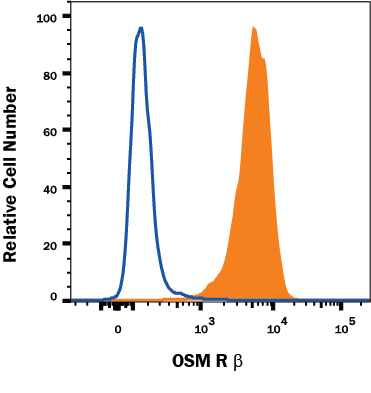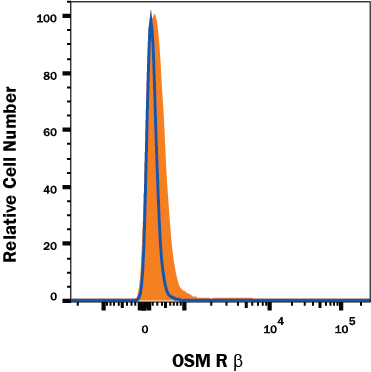Human OSMR beta Antibody Summary
Glu28-Ser739
Accession # Q99650
Applications
Please Note: Optimal dilutions should be determined by each laboratory for each application. General Protocols are available in the Technical Information section on our website.
Scientific Data
 View Larger
View Larger
Detection of OSM R beta in HeLa Human Cell Line by Flow Cytometry. HeLa human cervical epithelial carcinoma cell line was stained with Goat Anti-Human OSM R beta Antigen Affinity-purified Polyclonal Antibody (Catalog # AF4389, filled histogram) or isotype control antibody (Catalog # AB-108-C, open histogram), followed by Phycoerythrin-conjugated Anti-Goat IgG Secondary Antibody (Catalog # F0107).
 View Larger
View Larger
OSM R beta Specificity is Shown by Flow Cytometry in Knockout Cell Line. OSM R beta knockout HeLa epithelial carcinoma cell line was stained with Mouse Anti-Human OSM R beta Affinity Purified Polyclonal Antibody (Catalog # AF4389, filled histogram) or isotype control antibody (Catalog # AB-108-C, open histogram) followed by PE-conjugated anti-Goat IgG Secondary Antibody (Catalog # F0107). No staining in the OSM R beta knockout HeLa cell line was observed. View our protocol for Staining Membrane-associated Proteins.
Reconstitution Calculator
Preparation and Storage
- 12 months from date of receipt, -20 to -70 °C as supplied.
- 1 month, 2 to 8 °C under sterile conditions after reconstitution.
- 6 months, -20 to -70 °C under sterile conditions after reconstitution.
Background: OSMR beta
OSM R beta is a 150‑180 kDa member of the IL-6 receptor family. It associates with gp130 to form the type II OSM receptor that is responsive to OSM. The gp130 subunit is shared by other IL-6 family cytokine receptors (1, 2, 3, 4), and OSM R beta associates with gp130-like receptor (GPL) to form a receptor complex responsive to IL-31 (5, 6). The human OSM R beta cDNA encodes a 979 amino acid (aa) precursor that includes a 27 aa signal sequence, a 712 aa extracellular domain (ECD), a 22 aa transmembrane segment, and a 218 aa cytoplasmic domain. The ECD contains one partial and one complete hematopoietin domain, an Ig-like domain, and three fibronectin type-III domains. The cytoplasmic domain contains box1, 2, and 3 motifs (7). Within the ECD, human OSM R beta shares 55%, 58%, 61%, and 72% aa sequence identity with mouse, rat, bovine, and canine OSM R beta, respectively. It also shares 31% aa sequence identity with human LIF R, but less than 20% aa sequence identity with human CNTF R alpha, G-CSF R, IL-6 R, IL-11 R alpha, and TCCR. OSM R beta does not bind cytokines directly, but increases the affinity of gp130 for OSM, and GPL for IL-31 (7, 8). OSM R beta, gp130, and GPL each initiate signaling events following ligand stimulation (9, 10). Jak/STAT and MAPK pathways are activated by OSM R beta -containing receptors (9, 11, 12, 13), including STAT5b and SHC which are not activated by other IL-6 family receptors (10, 13). In mice, the loss of OSM R beta expression blocks erythroid progenitor development in bone marrow, and dramatically reduces the number of circulating platelets and erythrocytes (14). The type II OSM receptor is the only IL-6 family receptor that promotes osteoblast differentiation in calvaria cell cultures (15).
- Chen, S.-H. and E.N. Benveniste (2004) Cytokine Growth Factor Rev. 15:379.
- Heinrich, P.C. et al. (2003) Biochem. J. 374:1.
- Tanaka, M. and A. Miyajima (2003) Rev. Physiol. Biochem. Pharmacol. 149:39.
- Gearing, D.P. et al. (1992) Science 255:1434.
- Dillon, S.R. et al. (2004) Nat. Immunol. 5:752.
- Diveu, C. et al. (2003) J. Biol. Chem. 278:49850.
- Mosley, B. et al. (1996) J. Biol. Chem. 271:32635.
- Diveu, C. et al. (2004) Eur. Cytokine Netw. 15:291.
- Dreuw, A. et al. (2004) J. Biol. Chem. 279:36112.
- Wang, Y. et al. (2000) J. Biol. Chem. 275:25273.
- Hermanns, H.M. et al. (2000) J. Biol. Chem. 275:40742.
- Kuropatwinski, K.K. et al. (1997) J. Biol. Chem. 272:15135.
- Auguste, P. et al. (1997) J. Biol. Chem. 272:15760.
- Tanaka, M. et al. (2003) Blood 102:3154.
- Malaval, L. et al. (2005) J. Cell. Physiol. 204:585.
Product Datasheets
FAQs
No product specific FAQs exist for this product, however you may
View all Antibody FAQsReviews for Human OSMR beta Antibody
Average Rating: 2 (Based on 1 Review)
Have you used Human OSMR beta Antibody?
Submit a review and receive an Amazon gift card.
$25/€18/£15/$25CAN/¥75 Yuan/¥2500 Yen for a review with an image
$10/€7/£6/$10 CAD/¥70 Yuan/¥1110 Yen for a review without an image
Filter by:
Tried with various conditions on cells lysates without success by Western blot. However, when I tried an OSMR antibody from a different company on the same samples alongside, that worked no problem. The antibody was only tried for Western blot.


